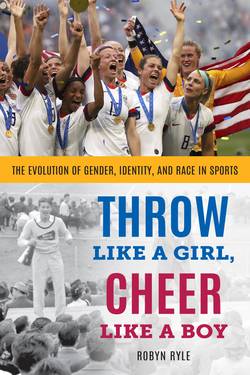Читать книгу Throw Like a Girl, Cheer Like a Boy - Robyn Ryle - Страница 9
На сайте Литреса книга снята с продажи.
Play Days, Tea, and Early Women’s Sports
ОглавлениеGirls in this time period weren’t leading cheers, but they still played sports, even if the sports they were playing were different from those of boys. For middle-class and upper-class women, physical education programs began at colleges and universities as early as the 1860s and 1870s. These programs were governed solely by women and gave college women an opportunity to participate in at least 14 different sports, with basketball being especially popular. Beyond college campuses, many working-class women bowled and played softball and basketball for industrial leagues, usually sponsored by companies or factories. At many high schools—especially small, rural schools that lacked enough students for intramural play or substituted competitive sports for physical education—women’s basketball thrived.[7]
As far back as the late nineteenth and early twentieth centuries, women were playing sports, but the idea of women athletes made some people nervous. Women who led physical education programs worked to ensure that the sports girls played never became too competitive, due to concerns that competition would lead to strenuous physical activity that might harm women’s menstrual cycles, their ability to have children, and their attractiveness to potential spouses. The fear was that if girls got too competitive on the basketball court, they might not be able to get married or become mothers, and these were seen as two central roles for women to fulfill.[8]
This fear of competitiveness meant that girls could play basketball, but not the same version of basketball that boys played. Not long after basketball was invented in 1891, female physical education professionals came up with a modified version of the game that would be safe and appropriate for girls. Girls’ basketball had six players rather than five, with three offensive and three defensive players on each team. Girls couldn’t cross the half-court line because it would cause too much exertion, and could only dribble three times before they had to pass the ball. In girls’ basketball, players were forbidden from doing anything as masculine as snatching the ball from their opponents. Not surprisingly, these rules made girls’ basketball a slower game to watch as well as to play.[9]
Those in charge of women’s sports were also concerned that too much competition would cause women emotional distress, sending them into a state of hysterics. Or that the women might get scratched up in a way that would lead to blemishes on their faces, which would destroy their “feminine charms.”[10] The question of who would watch women play sports also posed potential problems. Would men be allowed as spectators? What would women wear while they played, and how would they ensure their bodies were properly covered? How could women be protected from the hundreds of potentially leering eyes?
Because of these fears, women’s sports at the collegiate level remained a deeply segregated and secluded institution. From the top to the bottom, women’s sports were played and controlled by women who worked hard to protect female athletes from the dangers of too much competition, as well as what they saw as the commercialism and exploitation rampant in men’s sports. In men’s sports, the health and well-being of all athletes were sacrificed to the irresistible urge to win at all costs. Men’s sports produced stars, but they didn’t provide equal opportunities for all men to participate in physical education, which was an important goal for women’s sports participation.
Women’s physical education defined itself against the corrupt world of men’s sports, and that meant downplaying the competitive part of sports as much as possible. Instead of tournaments, women would often have “play days.” On play days, teams from other schools would come and visit—but rather than competing against each other, women from different schools would be distributed evenly across teams. The only way to tell who was from which schools were the colored pinnies (pinafores) or aprons they wore. All the women would share a locker room to encourage sociability and, at the end of the day, they might all have tea or a meal together before heading back to their home schools. Play days emphasized the participation of all over the elite performance of a few that characterized men’s sports.[11]
Some historically black colleges and universities (HBCUs) did depart from this noncompetitive model. This was because they were sheltered from or ignored by the dominant model of physical education programs at white colleges. That HBCUs decided to go their own way allowed them to develop some of the most successful women’s athletic programs of the time period. At Tennessee State University, the Tigerbelles developed a premier track and field program for their women athletes, winning the Amateur Athletic Union (AAU) competition every year from 1956 through 1968. Women from Tennessee State accounted for 25 of the 40 Olympic medals won by women in track and field between 1948 and 1968.[12]
